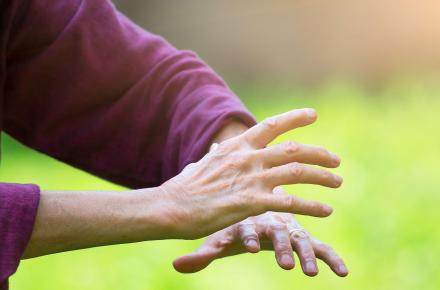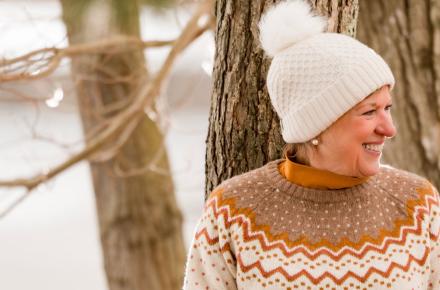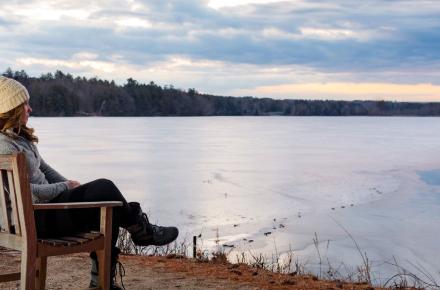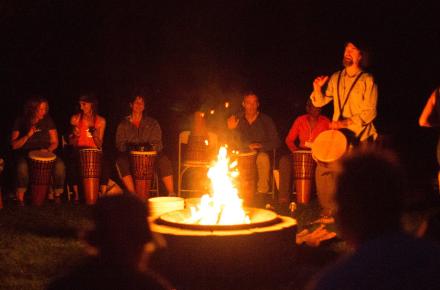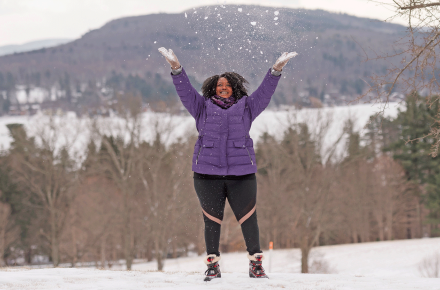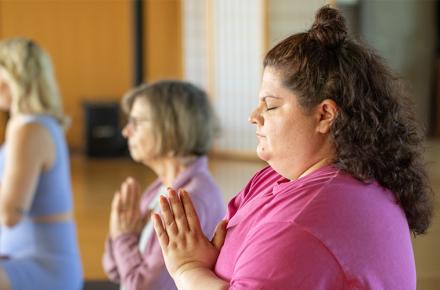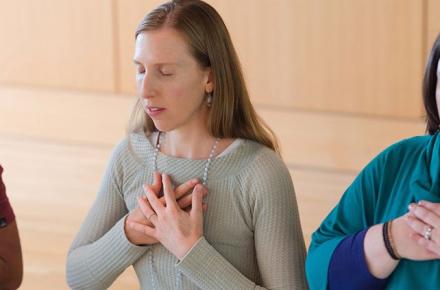Come On In, the Water’s Fine
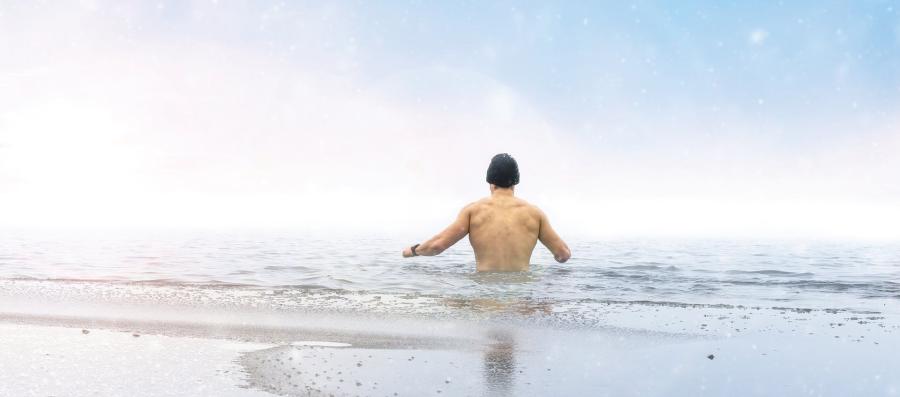
by Tresca Weinstein
If there’s one thing most everyone agrees on, it’s that we are all stressed out. Tech overuse, work pressure, environmental and political issues, relationships—being human in the 21st century is hard. We live in a state of constant low-level distress, even as we’re surrounded by a plethora of conveniences and creature comforts that pushes us ever farther from nature and from our own essential nature.
“We’ve disconnected from our natural rhythms and chained ourselves into a state of perpetual comfort that is driving us toward chronic stress, inflammation, and disease,” says Kripalu presenter Samuel Whiting. “We’ve lost our innate capacity to be healthy and happy.”
But what if you could enhance your ability to handle all of life’s daily irritations and its bigger challenges—and also reconnect to the natural world—by learning how to tolerate extreme cold? That’s the basis of the Wim Hof Method, which has become a topic of fascination for everyone from spiritual seekers and adrenaline junkies to research scientists and Joe Rogan fans.
“This practice gives you the inner confidence to face whatever life gives you,” says Sam, who was among the second group of Wim Hof teachers trained in North America. “It’s not about freezing into a popsicle. It’s about consciously engaging with an acute stressor, and coming out successfully on the other end.”
From the Slope to the Mat
Sam has never been afraid of the cold. He grew up in the great outdoors—riding his bike through the woods near his home in western Massachusetts, going to wilderness camp in Maine every summer, and learning to ski not long after he could walk. As a young adult, he became an alpine ski racer, traveling the world to compete.
But his body didn’t always want to go as hard as he did. “I was training really hard, and I dealt with a lot of anxiety and burnout that would lead to illness,” he recalls. “Every winter, I would get the flu and be sick for a month, which would leave me debilitated at the peak of the season. I could never catch up.”
So he retired from competitive skiing, went to college, and dove into another passion: music. He was pursuing a career as a deejay when he took his first yoga class. “It kicked my butt,” he remembers. “I was totally spent, but not drained or defeated. It was like I had cleared out a bunch of energy that wasn’t supporting me. I felt this clear space in myself that I had never felt before.”
He began practicing Baptiste Power Yoga, first three days a week, then every day, and became a certified teacher in 2015—soon leading up to 12 classes per week. And then he stumbled upon a video of Wim Hof on YouTube.
Into the Cold
Wim Hof is both a man and a myth—a superhuman legend among those who thrive on pushing the body to its outer limits. Born in the Netherlands in 1959, the Iceman, as he’s called, has set Guinness World Records for swimming under ice and for prolonged full-body contact with ice, and ran a barefoot half-marathon on ice and snow at the Arctic Circle.
Sam heard Wim’s origin story directly from the man himself. “He was walking to church on a Sunday morning and there was a frozen pond on the way. He walked out to it and felt called to get in the water. When he stepped in, that full-body immersion and the deep, gasping breath that the body responds with brought him into a deeper sense of feeling alive. He felt this connection to life itself, and he started diving into all these different disciplines to find that feeling again.”
Wim pursued that spark around the globe—climbing Mount Kilimanjaro in shorts, running a full marathon in the Namib Desert without drinking water, hanging by one finger at an altitude of a mile. And he always came back to the cold, accomplishing feats such as standing in a container while covered with ice cubes for more than 112 minutes.
It was the death of his wife by suicide in 1995 that drove Wim to further develop his techniques for entering low-temperature environments. “He started going back in the cold water, intuitively playing with breath practice,” Sam explains. “It was an outlet for healing the grief and pain.”
Unlocking Potential from the Ice
There are three pillars of the Wim Hof Method: breathing, cold, and mindset. Sam started with the breathing. “It was like yogic breathing practice, so it was easy for me to focus on,” he says. “I tried a simple breathing technique Wim teaches, and I burst into a whole different sense of what’s possible and a whole different sense of capacity in myself.”
Like many of us, Sam was very young—second grade—when he began creating self-limiting stories about who he was and what he could and couldn’t do. It started when he struggled with reading and didn’t learn how until after all his friends were already deep into the Redwall series. “I created this whole perception that I was stupid, and that followed me for a long time,” he recalls. “I held myself back because I was always looking for the easy way out. I didn’t believe I had the ability to do it on my own.”
With the Wim Hof Method, you don’t need to have blind faith in your own abilities, because you actually prove it to yourself. Using specific breathing techniques and mental focus, you learn to tolerate cold exposure and tap into your inner power. As Sam puts it, “You can’t hide in an ice bath.”
For him, as for thousands of others who ascribe to the method, achieving two minutes in a deep freeze unleashed a sense of confidence and of his own potential. The method allowed him, he says, to dig into his psyche, see the tricks his mind was playing on him, and free himself of those old thoughts and beliefs.
“The three pillars give you access into the power of your mind and the expansion of your awareness, awakening innate and adaptive capacities on a cellular level,” says Sam. “You’re able to consciously enter into stress and understand it as a process of growth.” He became a Wim Hof teacher in 2016, and transitioned from yoga teaching to focus entirely on sharing the method with others—including elite athletes, special operators, and corporate executives.
How It Works
According to Wim Hof, the benefits of the method are both mental and physical, including increased energy, better sleep, heightened willpower, enhanced focus and creativity, improved sports performance, and stronger immunity. Some of that can be explained by biological mechanisms: Consciously expanding our habitually shallow and constricted breathing, in combination with the effect of cold exposure on the body, strengthens the cardiac and respiratory systems, promotes blood flow, and changes the body’s pH and carbon dioxide levels.
“You’re getting a very dynamic nervous system workout,” Sam explains. “At first, there’s a sympathetic (fight-or-flight) nervous system reaction—the body wants to survive, so it kicks into heightened arousal. Then, through the techniques and focus you deploy in facing this acute stressor, you recalibrate the nervous system to break the loop of that stress and down-regulate into the parasympathetic (rest-and-digest) system. By stimulating both systems, you’re building a more balanced and versatile nervous system.”
In 2012, Wim Hof backed up his claims that he could influence his autonomic nervous system by allowing himself to be injected with an endotoxin that typically causes flu-like symptoms. He spent the next 80 minutes in meditation in an ice bath while researchers measured his response to the toxin, which was minimal (he had only a mild headache). Wim then set out to prove that anyone could be trained to do the same thing: For a second study, he trained 12 people in the method, and their responses to an endotoxin were compared to that of a control group who was not trained. The Wim Hof subjects were able to successfully control their immune response to the endotoxin, experiencing much less severe symptoms.
In a nutshell, the method trains the nervous system to lean into stress and challenges and find a balance, Sam says, promoting health, growth, and faster recovery. Like yoga, the Wim Hof Method strengthens the vagus nerve, which helps control parasympathetic activity and heart rate variability, a measure of stress resilience.
“Your nervous system is being reprogrammed in how it perceives and adapts to stress—whether it’s a traffic jam, a challenging situation with your boss, or a difficult conversation with a friend,” Sam says. “You can consciously engage with and regulate it instead of having it control you. This work sets you free to tap into the full expression of who you are and feel the true potential of who you can be. You can take down the walls that are keeping you from living an extraordinary life.”
Three Ways to Start a Cold Exposure Practice
You can start small when building a cold exposure practice, Sam says, working incrementally with the principles of stress and stimuli to promote growth and adaptation.
First and foremost, he cautions, always consult your primary care physician if you’re dealing with any health issue. People who have epilepsy or cardiovascular issues, or who are pregnant, should not practice these techniques.
For the rest of us, here are three simple ways to begin reaping the benefits of the big chill.
- At the end of your shower, turn the dial to cold for the last 30 seconds. During those 30 seconds, keep your breath slow, calm, and rhythmical. Notice how your body responds. After a week or two, extend the 30 seconds to one minute, or add in 30 seconds of cold at the beginning of the shower as well.
- On a cold winter day, wear one less layer that you normally would. To take it farther, step outside in a T-shirt or bathing suit. “Don’t go so far that you have a traumatic experience with cold,” Sam says, “but trust in your body’s ability to thermally regulate.”
- Take 10 steps barefoot in the snow. Notice where you’re tensing up and resisting the sensation. Keep your breathing calm and slow, and extend the exhalations. “Allow yourself to relax and surrender,” Sam says, “to get out of your thinking mind and simply be with nature.”
Tresca Weinstein is Features Editor at Kripalu.


























